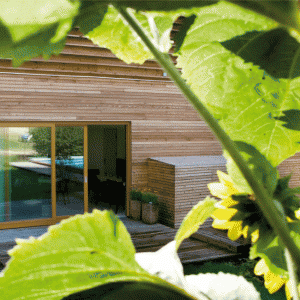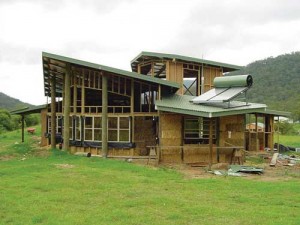After World War II, houses and buildings were erected quickly and cheaply as a means to rebuild Germany. However, many people living and working in these houses and buildings soon became noticeably ill, with all signs pointing to the new buildings as the cause. It was this phenomenon that inspired the baubiologie movement in Germany, and has since been infused in other parts of the world as well. Below are the 25 principles of baubiologie.

- Building site without natural and human-made disturbances
- Residential homes away from sources of emissions and noise
- Low-density housing with sufficient green space
- Personalized, natural, human- and family-oriented housing and settlements
- Building without causing social burdens
- Natural and unadulterated building materials
- Natural regulation of indoor air humidity through humidity-buffering materials
- Low total moisture content of a new building that dries out quickly
- Well-balanced ratio between thermal insulation and heat retention
- Optimal air and surface temperatures
- Good indoor air quality through natural ventilation
- Heating system based on radiant heat
- Natural conditions of light, lighting and color
- Changing the natural balance of background radiation as little as possible
- Without human-made electromagnetic and radiofrequency radiation exposure
- Building materials with low radioactivity levels
- Human-oriented noise and vibration protection
- With a pleasant or neutral smell and without outgassing toxins
- Reduction of fungi, bacteria, dust and allergens as low as possible
- Best possible drinking water quality
- Causing no environmental problems
- Minimizing energy consumption and utilizing as much renewable energy as possible
- Building materials preferably from the local region without promoting exploitation of scarce and hazardous resources
- Application of physiological and ergonomic findings to interior and furniture design
- Consideration of harmonic measures, proportions and shapes

In today’s world, very little attention is paid to the above-noted principles when building a new home or construction. The green movement has helped to push the world toward green building materials, and that is good, but so many new buildings are still being made with the cheapest and most toxic materials available. Furthermore, green does not always equal healthy for humans, even though oftentimes it does. Baubiologie goes a step beyond green building to recognize that inhabitants’ health is equally important to the building process as preserving the environment. It does so by placing an emphasis on both. This is what we need as we move forward in the 21st century – building practices that incorporate ecological and human health concerns at the top of every aspect of the building process.

 Rooftop Solar Lease Revisited: 5 Disadvantages or the Facts Leasing Companies Don’t Want you to Know
Rooftop Solar Lease Revisited: 5 Disadvantages or the Facts Leasing Companies Don’t Want you to Know Deconstruction vs. Demolition and Homes from Garage Doors in Mexico?
Deconstruction vs. Demolition and Homes from Garage Doors in Mexico? Eco Kids – How to Raise True Stewards of the Environment
Eco Kids – How to Raise True Stewards of the Environment